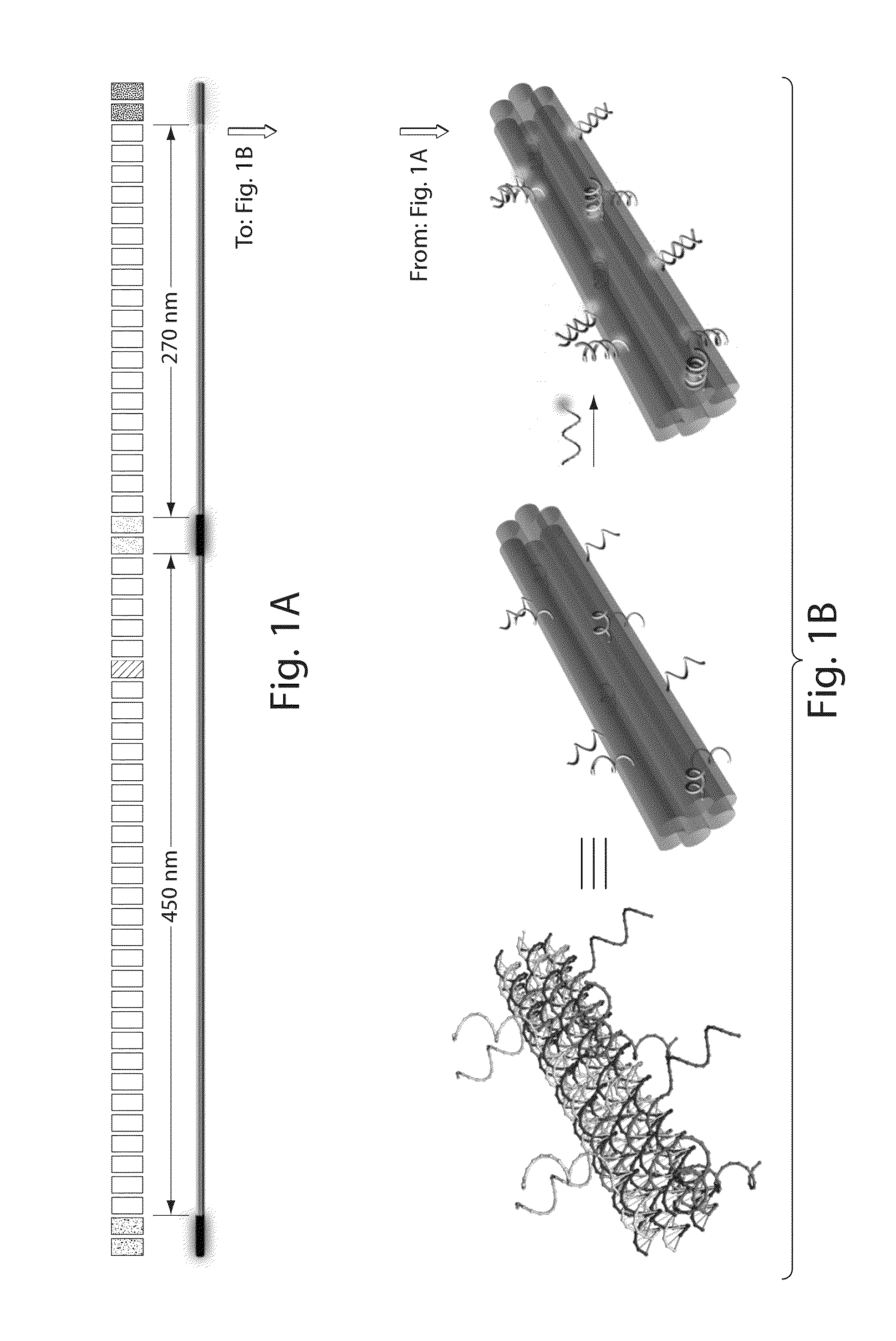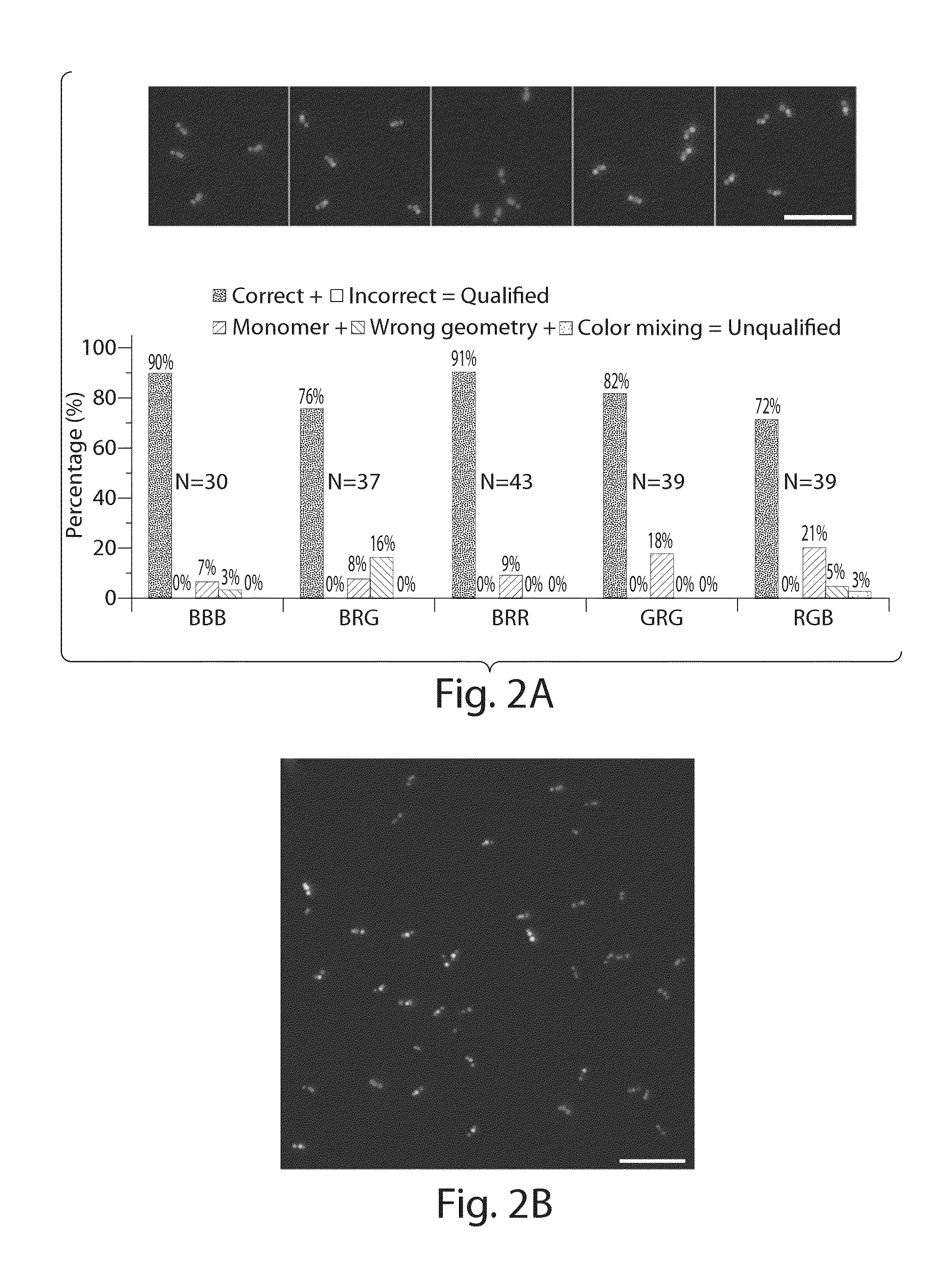Nucleic acid nanostructure barcode probes
a technology of nucleic acid and probes, applied in the field of nucleic acid barcode probes, can solve the problem of limited multi-plexing ability of fluorescent imaging
- Summary
- Abstract
- Description
- Claims
- Application Information
AI Technical Summary
Benefits of technology
Problems solved by technology
Method used
Image
Examples
example 1
[0083]DNA origami barcode probes were constructed by fluorescently labeling three separate regions of an 800-nm six-helix bundle dimer nanotube (FIG. 1). Each of the approximately 28 nm long fluorescently labeled regions was modified with twelve oligonucleotides attached to one of the three fluorophores (rhodamine-green, Cy3 or Cy5). The DNA origami barcode probe was designed to be asymmetric by placing the first two labeled regions further apart (approximately 460 nm apart) than the last two (approximately 270 nm apart). It is to be understood that other arrangements, including symmetric arrangements, are also contemplated by the invention.
[0084]The main structure of the DNA origami barcode probe is a DNA six-helix bundle nanotube dimer designed using the caDNAno software available at the cadnano website. The sequence of the scaffold strand used for each monomer is provided as SEQ ID NO: 1. The sequences of the staples used in the construction of the DNA or...
example 2
Detection of a Singly-Labeled DNA Barcode Using Fluorescent Microscopy
[0089]Two of the monomer nanotubes were folded and fluorescently labeled separately and combined together as described above to yield the nano-barcode. The final product was purified by agarose gel electrophoresis and directly deposited on a glass slide for imaging using a total internal reflection fluorescence microscope (TIRFM). In brief, 5 μL of the purified nano-barcode (˜20 pM) was deposited on a glass slide, sandwiched by a coverslip (No. 1.5, 18×18 mm2, ˜0.17 mm thick) and let sit for 5 minutes before being imaged on a Leica DM16000B TIRFM. The samples were imaged sequentially through three channels, each assigned a false color (blue, green and red). For the blue channel, the 488 nm laser beam was reflected by a dichroic mirror (430 / 505 / 575 / 670) and shined on the sample through a 100× objective (HCX PL APO 100× / 1.47 oil CORR TIRF, Leica). The emission light was collected through the same objective, filtered...
example 3
Detection of an Oligonucleotide Target Using a DNA Barcode Probe
[0097]A 42-nt DNA oligonucleotide target was detected using a DNA origami barcode probe. Two different purified barcodes Green, Red, Green (GRG) with the 21-nt oligonucleotide target capture moiety specific for a 42-nt oligonucleotide target (Target 1, see Table 3 for sequences) and Blue, Red, Green (BRG) without a target capture moiety, were mixed at 1:1 ratio and diluted to 20 pM in folding buffer. Biotin probe specific for Target 1 (0.2 μL of 100 nM) and Target 1 (0.4 μL, of 10 nM) was added to 100 μL of the barcode mixture. In a separate test tube containing 100μL of the barcode mixture, 0.2 μL of 100 nM biotin probe for Target 1 and 0.4 4. of 1× folding buffer was added as a negative control. The above samples were both incubated at 37° C. overnight before being run through separate channels of a micro-fluidic cell with a streptavidin coated glass cover-slip (Xenopore) substrate. Both channels were then washed with...
PUM
| Property | Measurement | Unit |
|---|---|---|
| diameter | aaaaa | aaaaa |
| distance | aaaaa | aaaaa |
| distances | aaaaa | aaaaa |
Abstract
Description
Claims
Application Information
 Login to View More
Login to View More - R&D
- Intellectual Property
- Life Sciences
- Materials
- Tech Scout
- Unparalleled Data Quality
- Higher Quality Content
- 60% Fewer Hallucinations
Browse by: Latest US Patents, China's latest patents, Technical Efficacy Thesaurus, Application Domain, Technology Topic, Popular Technical Reports.
© 2025 PatSnap. All rights reserved.Legal|Privacy policy|Modern Slavery Act Transparency Statement|Sitemap|About US| Contact US: help@patsnap.com



